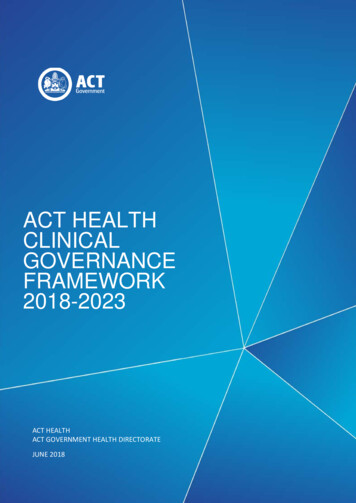
Transcription
ACT HEALTH CLINICAL GOVERNANCE FRAMEWORK 2018-2023ACT HEALTHCLINICALGOVERNANCEFRAMEWORK2018-2023ACT HEALTHACT GOVERNMENT HEALTH DIRECTORATEJUNE 2018June 20181
ACT HEALTH CLINICAL GOVERNANCE FRAMEWORK 2018-2023Document PropertiesApproval DetailsDate approved:27 June 2018Date effective:27 June 2018Approved version:1.0Approved by:Directorate Leadership CommitteeReview date:1 July 2019June 20182
ACT HEALTH CLINICAL GOVERNANCE FRAMEWORK 2018-2023CONTENTS1.2.3.June 2018INTRODUCTION51.1.Director-General’s Message51.2.Purpose61.3.ACT Health Vision and Values7CONTEXT92.1.The Role of Clinical Governance92.2.Accreditation102.3.National Safety and Quality in Health Service Standards102.4.Clinical Governance Domains11CLINICAL GOVERNANCE IN ACT HEALTH143.1.Principles of the ACT Health Clinical Governance Framework143.2.Organisational Structure163.3.Leadership Roles and Responsibilities163.4.ACT Health Committees193.5.Clinical Committee Governance Structure213
ACT HEALTH CLINICAL GOVERNANCE FRAMEWORK 2018-2023June 20184
ACT HEALTH CLINICAL GOVERNANCE FRAMEWORK 2018-20231. INTRODUCTION1.1.Director-General’s MessageThe ACT Health Clinical Governance Framework recognises that effective business systems areessential to the delivery of high quality, safe and effective health care. The clinical governancestructures described in this document are built on sound corporate governance and organisationalstructures which are aligned with the strategic goals and priorities articulated in the ACT HealthGovernance Framework.According to the Australian Commission on Safety and Quality in Health Care (the Commission),Clinical Governance is:“the set of relationships and responsibilities established by a health service organisation betweenits state or territory department of health (for the public sector), governing body, executive,clinicians, patients, consumers and other stakeholders to ensure good clinical outcomes. Itensures that the community and health service organisations can be confident that systems are inplace to deliver safe and high-quality health care, and continuously improve services.Clinical governance is an integrated component of corporate governance of health serviceorganisations. It ensures that everyone– from frontline clinicians to managers and members ofgoverning bodies, such as boards – is accountable to patients and the community for assuring thedelivery of health services that are safe, effective, integrated, high quality and continuouslyimproving.”(ACSQHC National Model Clinical Governance Framework, p2)Clinical governance is not only about compliance, it is about high performing health services and teamsthat achieve best outcomes for patients.The key principles that support the clinical governance framework are:o Clear accountabilityo Partnering with consumerso Effective planning and resource allocationo Strong clinical engagement and leadershipo Empowered staff and consumerso Robust data and sharing of clinical informationo Transparency and openness, ando Continuous improvement.The Clinical Governance Framework should be read in conjunction with the ACT Health GovernanceFramework, Corporate Plan and the Quality Strategy 2018-2028 and Quality and Safety ImplementationPlan and Measurement Framework.Michael De’AthInterim Director-GeneralJune 2018June 20185
ACT HEALTH CLINICAL GOVERNANCE FRAMEWORK 2018-20231.2.Purpose“Clinical Governance is a system through which organisations are accountable to the community forcontinually improving the quality of their services and safe guarding high standards of care,ensuring they are patient-centred, safe and effective.”Australian Commission on Safety and Quality in Healthcare – National Safety and Quality Health Service StandardsQuality care is delivered through a system of robust corporate and clinical governance frameworks toenable oversight of the health system that our patients, carers, families and community members(collectively referred to as consumers throughout this document), expect in the ACT.The ACT Health Clinical Governance Framework outlines the principles that ACT Health employs inorder to ensure high quality, person-centred, safe and effective health service delivery, underpinnedby a strong system of clinical governance. All staff have a responsibility and are accountable for thequality of our service and are therefore responsible and accountable for good clinical governance. Allstaff have an obligation to govern safe quality care for every consumer every time.The Clinical Governance Framework should be read in conjunction with the ACT Health GovernanceFramework, and is further reinforced by organisational-wide strategies and frameworks including theACT Health Quality Strategy 2018-2028 and the draft ACT Health Territory-wide Health ServicesFramework 2017-2027.For the Clinical Governance Framework to be effective, the associated clinical governance and qualityassurance structures and processes need to operate at all levels of the organisation.The successful implementation of clinical governance requires:o the identification of clear lines of responsibility and accountability for clinical care andensuring these are communicated and respected; ando the development of effective partnerships between clinicians and managers.The clinical governance, safety and quality assurance structures and processes must be wellunderstood, and be an embedded part of everyday operations.All staff have an opportunity, and responsibility, to input into the continuous development andimprovements of standards of clinical services within their stream/facilities and across the Territory.June 20186
ACT HEALTH CLINICAL GOVERNANCE FRAMEWORK 2018-20231.3.ACT Health Vision and ValuesACT Health’s vision is ‘Your Health – Our Priority’Our vision and values represent what we believe is important and worthwhile. Improving the quality ofhealthcare across the ACT is a key priority for ACT Health, as we aim to be the safest healthcare systemin Australia, delivering high‐quality, person‐centred care that is effective and efficient.We often see people in our community at their most vulnerable. The way we interact with them isextremely important and directly influences their experience of care. Our commitment to our values,as evidenced by our behaviour, can be summarised as: Care: Go the extra distance in delivering services to our consumers. Be diligent, compassionateand conscientious in providing a safe and supportive environment for everyone. Be sensitive inmanaging information and ensuring an individual’s privacy. Be attentive to the needs of otherswhen listening and responding to feedback from staff, clinicians and consumers. Excellence: Be prepared for change and strive for continuous learning and quality improvements.Acknowledge and reward innovation in practice and outcomes. Develop and contribute to anenvironment where every member of the team is the right person for their job and is empoweredto perform to the highest possible standard. Collaboration: Actively communicate to achieve the best results by giving time, attention andeffort to others. Respect and acknowledge everyone’s input, skills and experience by workingtogether and contributing to solutions. Share knowledge and resources willingly with yourcolleagues. Integrity: Be open, honest and trustworthy when communicating with others and ensure correctinformation is provided in a timely way. Be accountable, reflective and open to feedback. Be trueto yourself, your profession, consumers, colleagues and the government.ACT Health’s vision is supported by a range of goals and priorities:June 20187
ACT HEALTH CLINICAL GOVERNANCE FRAMEWORK 2018-2023June 20188
ACT HEALTH CLINICAL GOVERNANCE FRAMEWORK 2018-20232. CONTEXT2.1.The Role of Clinical GovernanceClinical governance provides a resilient structure to the delivery of clinical services, coordination andimplementation of systems of care, analysis and improvement of services to establish and maintainorganisational performance and accountability.The diagram below shows how the person is at the centre of ACT Health system design and howindividual interactions build a framework of care supported by professional and management systems.In the final arc, governance committees ensure a consistent expectation, management and evaluationof care throughout the system.June 20189
ACT HEALTH CLINICAL GOVERNANCE FRAMEWORK 2018-20232.2.Accreditation2.3.National Safety and Quality in Health Service StandardsAccreditation is independent recognition that an organisation, service, program or activity meets therequirements of defined criteria or standards. Accreditation provides quality and performanceassurance for owners, managers, staff, funding bodies and consumers. In addition to the NationalSafety and Quality Health Service (NSQHS) Standards, some clinical areas and services participate inadditional specialty accreditation systems that are relevant to their particular specialty.The National Safety and Quality Health Service (NSQHS) Standards were developed by the theAustralian Commission on Safety and Quality in Health Care (the Commission) with the AustralianGovernment, state and territory partners, consumers and the private sector.The primary aim of the Standards is to protect the public from harm and improve the quality of healthcare. They describe the level of care that should be provided by health service organisations and thesystems that are needed to deliver such care. Delivery of the ten Standards is an implicit part ofdelivering quality care and is integral to our core business as a health system. The ten Standards are:1. Governance for Safety and Quality in Health Service Organisations which describesthe quality framework required for health service organisations to implement safesystems.2. Partnering with Consumers which describes the systems and strategies to create aconsumer-centred health system by including consumers in the development and designof quality health care.3. Preventing and Controlling Healthcare Associated Infections which describes thesystems and strategies to prevent infection of patients within the healthcare system andto manage infections effectively when they occur to minimise the consequences.4. Medication Safety which describes the systems and strategies to ensure clinicianssafely prescribe, dispense and administer appropriate medicines to informed patients.5. Patient Identification and Procedure Matching which describes the systems andstrategies to identify patients and correctly match their identity with thecorrect treatment.6. Clinical Handover which describes the systems and strategies for effective clinicalcommunication whenever accountability and responsibility for a patient’s care istransferred.7. Blood and Blood Products which describes the systems and strategies for the safe,effective and appropriate management of blood and blood products so the patientsreceiving blood are safe.8. Preventing and Managing Pressure Injuries which describes the systems and strategiesto prevent patients developing pressure injuries and best practice management whenpressure injuries occur.9. Recognising and Responding to Clinical Deterioration in Acute Health Care whichdescribes the systems and processes to be implemented by health service organisationsto respond effectively to patients when their clinical condition deteriorates.10. Preventing Falls and Harm from Falls which describes the systems and strategies toreduce the incidence of patient falls in health service organisations and best practicemanagement when falls do occur.Further information:June 2018ACT Health National Standards SharePoint SiteAustralian Commission on Safety and Quality in Health Care10
ACT HEALTH CLINICAL GOVERNANCE FRAMEWORK 2018-20232.4.Clinical Governance DomainsACT Health adopts the Commission’s National Model Clinical Governance Framework. There are fivekey domains of the Clinical Governance Framework which are embedded in the quality improvementprocess (see figure below):Partnering with consumersA consumer or carer perspective brings different and important dimensions to what constitutes safeand quality health care. It is through working alongside consumers, and listening to and learning fromtheir participation, that it is possible for health services to truly appreciate what constitutes quality,safe health care.ACT Health supports the Charter of Healthcare Rights (2012) and consumers are actively encouragedto provide feedback on their experiences. This information is used for driving improvements within theorganisation.Governance, leadership and cultureOrganisational culture which emphasises quality as a shared value central to clinical work is a majorenabler that underlies all aspects of the organisation’s activities. Our focus must be on creating a culturewhere every staff member provides person-centred, safe high quality care for every person every time. Insetting the scene for a safety culture, activities need to be acknowledged as being at risk for error andincidents. Staff need to be supported to freely communicate their concerns, in identifying a risk oruncovering an error and have clear mechanisms to escalate risks and errors appropriately.Integral to the delivery of high quality, person-centred, safe and effective healthcare is the development of arespectful, transparent and just culture within which health care providers and others can report safetyincidents without fear of blame. The organisational culture needs to encourage and support reflectivepractice, learning from experience, use and dissemination of knowledge, partnerships with stakeholders andeffective leadership in order to enable systematic improvement in service quality.Leadership is a critical element in successful safety and quality improvement programs and is non-delegable.Although safety and quality is everyone’s responsibility, senior leaders have a key role to direct efforts inhealth care to foster and role model the culture and commitment required to address the underlying systemcauses of error in health care provision, reduce harm to consumers and focus endeavours on improving thequality of care.June 201811
ACT HEALTH CLINICAL GOVERNANCE FRAMEWORK 2018-2023Safe environment for the delivery of careThe provision of safe and high-quality healthcare for consumers is achieved through coordination andplanning, along with appropriate allocation of resources. The workforce is an integral part of a safeenvironment for the delivery of care. Clinicians should be engaged in planning and developmentactivities, encouraged to be vigilant and identify opportunities for improvement and supported to raiseand report these appropriately through clearly identified pathways. Consumers play an important rolein a safe environment for the delivery of care. Their feedback about experiences of the environmentof the health service identify opportunities for improvement and potential safety and quality risks.Creating a safe environment that provides safe and high quality health care requires continuousimprovement. Measurement is a vital part of improvement – if we do not measure we have no way ofknowing if the changes or intended improvements have had any impact.We recognise that our measurement of quality needs to be varied in order to triangulate measurement ofthe safety, effectiveness and experience users have of our services. The ACT Health Quality Strategy issupported by the Quality and Safety Implementation Plan and Measurement Framework 2018-2028. TheMeasurement Framework sets out a number of measures which align with the key strategic priorities, usingdata for quality planning, quality assurance and quality improvement.Patient safety and quality improvement systemsPatient safety and quality improvement systems have safety and quality systems integrated withgovernance processes to actively manage and improve the safety and quality of healthcare forconsumers. Safety and quality systems, such as risk management, must involve all members of theclinical workforce with periodic review of performance.Risk Management to minimise harm and safeguard against clinical risk requires a structured approachto safety that is both proactive and reactive. Risk management aims to prevent harm from occurringand mitigating the risk of harm when prevention is not able to occur.Identification of risks can come from a variety of sources: Reporting of clinical incidents and work health and safety incidents via the RiskMan incidentreporting system Staff raising identification of risks and near misses through the management structure. It isimperative that the organisational culture support staff to speak up about identified risks tosafety of staff and consumers knowing they will be listened to and without fear of blame The open disclosure process. This process allows open and transparent identification of errorsthat occurred in patient care and can lead to identification of system/process issues.Identified risks and data should be used to inform priority settings which lead to development ofbusiness plans for the organisation.Clinical risk can be reduced by ensuring clinical practice is supported by a robust evidence base.Evidence based clinical practice reduces variation in care received by consumers. To achieve this,clinical care is supported by policy documents that prescribe or guide a clinicians care of the patient.The clinical policy documents in ACT Health are governed by the Canberra Hospital and Health ServicePolicy Committee with documents available on the central ACT Health Policy Register.Clinical performance and effectivenessClinical performance and effectiveness relates to processes that exist to ensure that the workforce hasthe right qualifications, skills and supervision to deliver safe and high-quality care. High level clinicalperformance and effectiveness is achieved through implementing robust organisational systems toperiodically review system and individual performance. This includes credentialing and defining scopeof clinical practice, clinical education and training, performance monitoring and management,systematic monitoring of safety and quality performance across the organisation.Further information: National Model Clinical Governance FrameworkJune 201812
ACT HEALTH CLINICAL GOVERNANCE FRAMEWORK 2018-2023June 201813
ACT HEALTH CLINICAL GOVERNANCE FRAMEWORK 2018-20233. CLINICAL GOVERNANCE IN ACT HEALTH3.1. Principles of the ACT Health Clinical Governance FrameworkThe ACT Health Clinical Governance Framework is premised on the following principles: Person-centred – improving the experience of carePatient Safety – proactively seeking a reduction in patient harmEffective care – best evidence of every person, every time.These principles are consistently reflected in the ACT Health Quality Strategy and associated Qualityand Safety Implementation Plan and Measurement Framework.Person-CentredPerson-centred care is a way of thinking and doing things that sees health care users as equal partnersin planning, delivering and monitoring the improvement of safe, quality care that meets their needs.This means putting people and their families at the centre of decisions and seeing them as experts,working alongside health professionals to achieve the best outcomes. By shifting the culture from“doing to” to “doing with” significant clinical and financial improvements can be made.Making sure people are involved in and are central to their care is now recognised as a key componentof delivering high-quality health care. The term “patient experience” is frequently used to describe aperson’s experience when accessing health care services. Where an organisation is committed todelivering person-centred care, the patient experience improves.Consumers are engaged across various levels of governance, and are actively involved in developingand improving the health service.To bring about a positive consumer experience: We involve our consumers in the development of information, resources and communicationstrategies for consumers; We use consumer complaints, compliments, experience surveys and data from patientexperience trackers; We use information from consumer representatives and community organisations to informimprovements; We have established strategies to involve consumers in improvement activities.Person-centred care is achieved through: Involving consumers in planning and shared decision making at all levels of the service Understanding the barriers for consumers to understand and use health services, and developstrategies to improve Ensuring the organisation has effective systems for consumer feedback, complaints and opendisclosure, and effectively monitor the performance of these systems.We use consumer complaints, compliments, experience surveys and data from patient experiencetrackers as well as information from consumer representatives and community organisations to informimprovements and have established strategies to involve consumers in improvement activities.Staff are guided by the ACT Health Consumer Feedback Management Policy which recognises theimportance of seeking and collecting feedback from our consumers, and supporting them to becomemore involved in their health and healthcare.Consumers and their families are informed and are involved in decisions about their own care. Frontline staff act on local feedback to improve the consumer experience every day. Line managers have animportant role to play in developing a positive culture regarding feedback. As part of this, consumersand families are advised of how their feedback has been addressed.June 201814
ACT HEALTH CLINICAL GOVERNANCE FRAMEWORK 2018-2023Patient SafetyOur first obligation is to ensure that by coming into our care, we make every effort to keep consumerssafe and the risk of harm is reduced.Patient safety is our highest priority and we will work relentlessly to proactively seek a reduction inpatient harm. This includes health care adverse events that have a negative effect on care, even if theyare not negative or harmful to the patient. We strive for: No avoidable harm Avoidance of and a reduction in adverse events Reducing hospital acquired complications Learning from incidents and reducing risk of reoccurrence Creating a culture of psychological safety.Patient Safety is achieved through: Monitoring, identifying and responding to risks, incidents and opportunities for improvement Supporting a “blame-free”, accountable and learning culture Comprehensive planning and development to ensure the environment of the health servicepromotes safe and high quality care Implementation of a robust policy and procedure framework, such as the IncidentManagement Policy and Procedure, with active engagement of all staff Incorporating systematic audits of safety and quality systems Ensuring availability of data and information to support quality assurance and review acrossthe organisation.Some of the measures we use to inform and monitor patient safety and continuous improvementinclude: Discharged inpatient survey Compliments and complaints Hospital diagnosis standardised mortality Hospital acquired complications (HACs) Sentinel Events Significant clinical incidentsEffective CareAn effective health care system is one that promotes and supports evidence-based, effective andreliable care provision. There should be no variation in the quality of care, which should be provided inan atmosphere of mutual trust where staff members can talk freely about safety problems and how tosolve them. The safety and quality of care has been found to be seriously compromised duringtransitions of care where consumers are moved between health professionals and clinical settings andwhere management and treatment plans are not effectively communicated.Effective care is characterised fundamentally by: The alignment of evidenced based health care to evidenced based delivery A culture which supports continuous improvement and monitoring for improvement.Effective care can be achieved through the: Development of clinical reliability tools (e.g. guidelines for particular diseases and clinicalinterventions) Introduction, use, monitoring and evaluation of evidence based clinical pathways Monitoring of practice variance using tools such as clinical audit, continuous datameasurement, and clinical indicators Peer review processes Maintenance of professional skills, competence and performance, including credentialing anddefining scope of practice, performance monitoring and management.June 201815
ACT HEALTH CLINICAL GOVERNANCE FRAMEWORK 2018-20233.2.Organisational StructureThe ACT Health Director‐General leads ACT Health in the delivery of its vision and strategic goals.The Director-General is supported by six Deputy Directors-General to lead each Division of theorganisation, these Divisions are: Canberra Hospital and Health Services; Corporate; Innovation; Performance, Reporting and Data; Population Health Protection and Prevention; Quality, Governance and Risk.ACT Health’s Canberra Hospital and Health Services (CHHS) Divisionprovides acute, subacute, primary and community‐based healthservices to the ACT and surrounding region through its key servicedivisions.Canberra Hospital and Health Services is supported by key clinical caredivisions. Each division has Clinical and Executive Managementleadership to enable high quality patient care to be delivered.The clinical leadership team ensures that consumers are appropriatelycared for, and that clinical care is evidence-based, with appropriateclinical supports.Executive Directors are responsible for ensuring the clinical andsupport systems are aligned and functioning together to enableclinicians to deliver quality and safe health care. This includes a focuson engaging consumers in the design of new models of care, effectivemobilisation of support functions such as HR, finance, data andreporting and procurement.3.3.Leadership Roles and ResponsibilitiesClinicians, managers and members of governing bodies have responsibility for ensuring safety andquality of clinical care. There is an expectation that all staff will deliver safe, quality health care forevery patient, every time. It is the ultimate responsibility of a governing body to set up a sound clinicalgovernance system and be accountable for performance and outcomes, implementation depends onthe contribution of individuals and teams at all levels of the organisation.In addition to clinical and executive leadership in divisional roles, these key roles also haveresponsibility for contribution, operations and continuous improvement of clinical governance. Theseinclude:Director-GeneralThe Director-General has overall accountability for both clinical and corporate governance and isresponsible for overseeing progress against strategic objectives. The Director-General reports to theACT Minister for Health and Wellbeing and the ACT Minister for Mental Health.Deputy Director-General, Canberra Hospital and Health ServicesResponsible for overseeing the appropriate implementation and response to clinical governance withinCanberra Hospital and Health Services Divisions to ensure high quality, person-centred, safe andeffective care. Canberra Hospital and Health Services provides acute, subacute, primary andcommunity-based health services to the ACT and surrounding region through its key service Divisions.The Deputy Director-General of Canberra Hospital and Health Services works closely with all DeputyDirectors-General of ACT Health.June 201816
ACT HEALTH CLINICAL GOVERNANCE FRAMEWORK 2018-2023Professional LeadsChief Medical Officer (CMO) provides leadership and support to develop and implement clinicalgovernance across the organisation. The Office is responsible, through working collaboratively with allExecutive Directors, the other professional leads and Clinical Directors, for promoting qualityleadership and clinical engagement. The Office sets and assures high standards of professional andclinical practice through the coordination of medical research and clinical trials; local GeneralPractitioner liaison; the Junior Medical Officer workforce and credentialing; and scope of practiceprocesses for medical and dental appointments. Advice is provided at multiple levels includinginternally to ACT Health and the broader ACT Government as well as to other government and nongovernment agencies as relevant.The CMO has specific governance of a cohort of junior medical officers i.e. PGY1 and PGY2. This iscoordinated by the Medical Officer Support Credentialing Education and Training Unit (MOSCETU). Allother medical staff including Registrars are governed by the Executive Director of the respectiveclinical divisions.ACT Chief Nursing and Midwifery Officer (CNMO) provides professional leadership across theTerritory to the nursing and midwifery workforce is to develop, implement and support continuousquality improvement in the delivery of safe, effective and person-centred care and services. TheCNMO sets and assures high standards of professional and clinical practice through supportive systemsand processes of clinical governance, including practice development, role development, andeducation and continuing professional development, workforce planning, and participating inresearch, audit and evaluation processes. The CNMO is responsible for promoting quality leadershipand clinical engagement by working collaboratively with all Executive Directors, the other professionalleads and Directors of Nursing and Midwifery across the Territory, as well as with Chief Nursing andMidwifery Officers in other states and territories, and the Australian Health Practitioner RegulationAgency (AHPRA) and the Australian Nursing and Midwifery Advisory Council (ANMAC). Advice isprovided at multiple levels including internally to ACT Health and the broader ACT Government as wellas to other gove
2.1. The Role of Clinical Governance 9 2.2. Accreditation 10 2.3. National Safety and Quality in Health Service Standards 10 2.4. Clinical Governance Domains 11 3. CLINICAL GOVERNANCE IN ACT HEALTH 14 3.1. Principles of the ACT Health Clinical Governance Framework 14 3.2. Organisational Structure 16 3.3. Leadership Roles and Responsibilities 16 .










